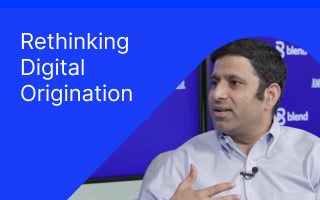January 12, 2021 in Platform and services
How Blend microservices enable consistency across the consumer lending enterprise
With less maintenance work dedicated to legacy code and more cohesion between systems, data, and user experiences, tech teams face fewer time-draining issues.

Not long ago, most consumer banking organizations focused primarily on providing an exceptional branch experience. It can seem easier to provide a consistent experience as a banker in a branch, discussing the available options with a borrower in person. In those instances, winning customer service can mask any underlying technological challenges behind the scenes.
Over the past year, the lending landscape has seen major shifts caused by COVID-19 and the ensuing economic recession. Financial institutions around the country are in varying stages of digital transformation, but this year has greatly accelerated the need to embrace and improve digital offerings. Digital channels have become the main way lenders interact with consumers and their expectations have never been higher. Disconnected systems and technology silos previously hidden behind the curtain are now on full display for consumers.
In addition to the accelerated need for more consistent, polished digital experiences across products, this year highlighted the importance of agility when reacting to unpredictable market conditions. As novel consumer needs arise, financial institutions are being called on to quickly modify or spin up new lending products to match demand.
Blend’s microservices architecture empowers your teams to ensure an excellent level of service and consistency across products — even those that are created quickly. Dive into the advantages of microservices-based development with Blend so you can respond to consumer expectations and deliver innovation faster than ever before.
3 benefits for lenders using microservices-based development with Blend
1) Efficiency across lines of business
Without a microservices architecture, lenders are effectively reinventing the wheel for every new offering, building the application experience, business logic, and data layer all from the ground up. This process can be unnecessarily time-consuming while requiring extensive maintenance.
Blend provides fully functional modules and services for required elements — like assets/income verification, eSignature, and eClosing — that can be leveraged throughout the business, so there’s no need to repeat work for similar deployments and integrations. This creates efficiency for your teams when they’re spinning up new products across LOBs.
2) Minimize friction with a consistent experience
Blend’s Digital Lending Platform enables lenders to provide the same level of excellence and service across product portfolios. Our consistent user experience helps build and maintain trust with consumers — after one interaction, they’ll know what to expect for the future. This consistency also reduces friction for borrowers, since they’ll intuitively know how to navigate through digital interactions and get to close faster.
3) Future-proof digital lending tools
The elements packaged to power your business within Blend’s Digital Lending Platform are continuously updated. Since these updates apply to all products at once, tech teams spend less time maintaining legacy code.
As these Blend microservices are updated, your teams can choose how to leverage them through direct configuration and customization, based on enterprise or line of business needs. For example, as consumer demands change for personal loans, that team can make the appropriate changes — leaving the deposit accounts team and any other lines of business to structure their own, market-relevant path forward. Consumer expectations are constantly changing, but not necessarily consistently across products; a microservices approach offers lenders the flexibility to respond appropriately.
In addition, lenders can customize product experiences, orchestration, data services, and integrations as needs evolve over time, all embedded within our white-labeled platform. A static experience is a quickly forgotten experience. Blend microservices help offer your customers access to the best of what’s on offer at any given time.
With less maintenance work dedicated to legacy code and more cohesion between systems, data, and user experiences, tech teams face fewer time-draining issues. Blend empowers tech teams to focus on future innovation.
Adapt and scale with Blend
Blend’s unified Digital Lending Platform provides a framework for improved agility so that lenders can respond to market shifts and evolving consumer demand. Our dynamic approach and continuous updates make it easier for financial institutions to adapt and expand product offerings while providing a consistently excellent consumer experience.
There are countless examples of empowered lenders utilizing this approach to create positive impact, but few are more dramatic than last year’s case with M&T Bank. When the Coronavirus Aid, Relief, and Economic Security (CARES) Act was on its way to being passed, banks knew that they’d be inundated with SBA loan applications. We collaborated with M&T to adapt our platform — its flexible framework made it possible to rapidly create a brand-new application workflow that complied with the newly implemented SBA guidelines.
Maintaining consistency with the existing mortgage product M&T already utilized, our teams finalized integrations like single sign-on and customer profile data while they modified the Blend platform to match the SBA Paycheck Protection Program workflow. The live, self-serve application was up and running in just 72 hours.
As the lending landscape continues to transform, Blend’s platform will support the agility required to adapt to the ever-increasing pace of change.
Learn how to stay nimble and navigate change
Find out what we're up to!
Subscribe to get Blend news, customer stories, events, and industry insights.


